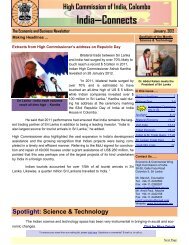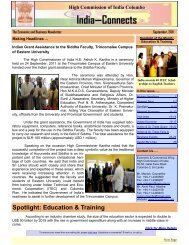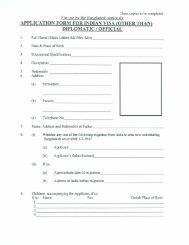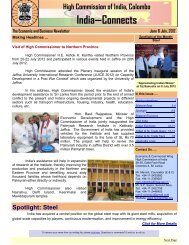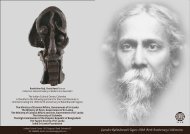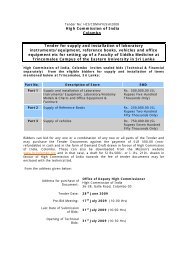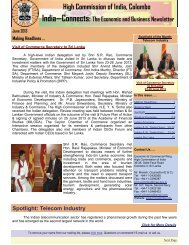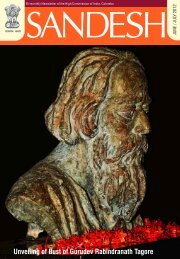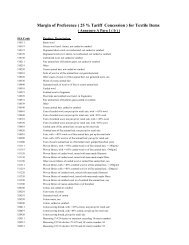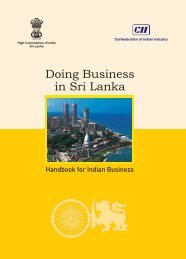Papers presented at the International Buddhist Conference, March ...
Papers presented at the International Buddhist Conference, March ...
Papers presented at the International Buddhist Conference, March ...
You also want an ePaper? Increase the reach of your titles
YUMPU automatically turns print PDFs into web optimized ePapers that Google loves.
The Stūpas of Bahusrutiyās:<br />
Chetiyagharas <strong>at</strong> Nagarjunakonda:<br />
In <strong>the</strong> Nagarjunakonda valley more than twenty chetiyagharas<br />
have been brought to light. They are mostly apsidal with two or<br />
three exception which is circular in plan. Chetiyagharas <strong>at</strong><br />
Nagarjunakonda can also be analyzed as per <strong>the</strong> existence of<br />
chetiyagharas in <strong>the</strong> monastic units, as done by H Sarkar like<br />
• Unit with no chetiyaghara<br />
• Unit with chetiyaghara with stūpa inside<br />
• Unit with both, chetiyaghara with stūpa and chetiyaghara<br />
with image inside.<br />
• Unit with chetiyaghara with image inside.<br />
The Bahusrutiyās are <strong>the</strong> second most popular sect in <strong>the</strong> valley<br />
and three establishments of Nagarjunakonda belong to <strong>the</strong><br />
Bahusrutiyās. They are Site 5, <strong>the</strong> largest in Nagarjunakonda, Site<br />
32 A and Site 26.<br />
Unit with no chetiyaghara:<br />
Apārāmahāvinaseliyas Stūpas:<br />
As indic<strong>at</strong>ed by <strong>the</strong> inscriptional evidences <strong>the</strong> Aparasailas are <strong>the</strong><br />
most significant of <strong>the</strong> <strong>Buddhist</strong> sects of Nagarjunakonda valley.<br />
There are about five establishments, which can be definitely being<br />
<strong>at</strong>tributed to <strong>the</strong>m. They are Site 1, <strong>the</strong> Mahāchaitya, Site 2, Site 3,<br />
Site 4 and Site 9.<br />
usually <strong>the</strong> monastic unit <strong>at</strong> Nagarjunakonda consists of a stūpa,<br />
chetiyaghara and vihāra. But <strong>the</strong>re are sites where no chetiyaghara<br />
is seen and sometimes in <strong>the</strong> early phase of <strong>the</strong> Site, absence of <strong>the</strong><br />
chetiyaghara is marked. Such Sites are: Site-6, Site-7 & 8, Site-14,<br />
Site-15, Site-20, Site-21, Site-27, Site-30, Site-32A, Site-32B,<br />
Site-54, Site-86 and early phase of Site-1, Site-38 and Site-43.<br />
Unit with chetiyaghara with stūpa inside:<br />
Stūpas with Swāstikā Inset <strong>at</strong> Nagarjunakonda:<br />
There are three stūpas <strong>at</strong> Nagarjunakonda valley with swastikā<br />
inset. Swastikās are arranged in <strong>the</strong>se stūpas with bricks, below <strong>the</strong><br />
found<strong>at</strong>ions, more or less on <strong>the</strong><br />
ground level. These swastikās being<br />
in <strong>the</strong> centre of <strong>the</strong> base are not visible<br />
f r o m o u t s i d e . S i n c e s u c h<br />
arrangements cannot have any<br />
architectural significance, it was<br />
definitely done on ideological<br />
consider<strong>at</strong>ions. The sites with<br />
Swastikā inset stūpas are Site 20,<br />
Site 59 and Site 108. Interestingly all<br />
<strong>the</strong> above sites are arranged side by<br />
side in a row.<br />
Votive stūpas <strong>at</strong> Nagarjunakonda:<br />
Several votive stūpas are unear<strong>the</strong>d<br />
<strong>at</strong> <strong>the</strong> valley of Nagarjunakonda. All<br />
<strong>the</strong> votive stūpas <strong>at</strong> Nagarjunakonda<br />
are made of solid core and without<br />
āyakā- pl<strong>at</strong>forms, with <strong>the</strong> exception<br />
of votive stūpa <strong>at</strong> Site-2. The sites<br />
having votive stūpas are Site 2, Site<br />
6, Site 9, Site 15, Site 23, Site 38,<br />
Site 106, Site 108.<br />
Of all <strong>the</strong> monasteries in <strong>the</strong> valley <strong>the</strong> sites, which had only <strong>the</strong><br />
apsidal chetiyagharas with stūpa inside, are: Site-1[l<strong>at</strong>e phase],<br />
Site-5, Site 23, Site 24, Site 26, Site 28, Site 32, Site 43, Site 51 and<br />
Site 108. Site-5 and Site-26 both had two chetiyagharas with stūpa<br />
inside and belong to <strong>the</strong> Bahusrutiyā sect. They are connected with<br />
ano<strong>the</strong>r peculiar architectural fe<strong>at</strong>ure in <strong>the</strong> form of a structure,<br />
which are externally circular and internally square. Site-32A also<br />
has this fe<strong>at</strong>ure and is also <strong>at</strong>tributed to <strong>the</strong> sect of Bahusrutiyā.<br />
Site-1 belonged to <strong>the</strong> Apārāmahāvinaseliyas. Site-43 (l<strong>at</strong>e phase),<br />
Site-32 and Site-23, with <strong>the</strong> apsidal chetiyaghara inside vihāra<br />
complex belonged to <strong>the</strong> Theravādins. Site-24 had one apsidal<br />
chetiyaghara for stūpa and two circular chetiyaghara for images,<br />
though no images are found <strong>at</strong> <strong>the</strong> valley. Site-51 is <strong>the</strong> only site<br />
with chetiyaghara with stūpa and vihāra with no stūpa, though <strong>the</strong><br />
chetiyaghara is well preserved. Site-108 also has a very<br />
domin<strong>at</strong>ing chetiyaghara, but it also has <strong>the</strong> vihāra and stūpa in <strong>the</strong><br />
unit.<br />
48



